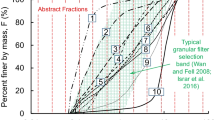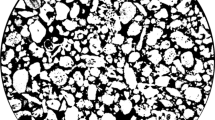Abstract
Seepage-induced failures in granular soils pose a potential hazard for geotechnical engineering, but the types and mechanisms of seepage failures have not been fully clarified. In this paper, the mass fractal dimensions of testing soils were used to describe the cumulative mass distribution of particles, which was closely related to the uniformity coefficient, fine content, porosity, dry density and permeability coefficient. A series of hydraulic tests were performed to show seepage failure behaviors of sandy gravels, coarse sands and fine sands. By linking the mass fractal dimension to the critical hydraulic gradient, a zone segmentation approach for seepage failure types was proposed to distinguish seepage failures, including piping, suffosion and heave. Piping failure originates from internal instabilities in inhomogeneous soils and has been observed in sandy gravel samples. Suffosion occurs in coarse sand samples due to external and internal erosion of loose particles. Heave failure is dominated by fine content and has been observed in fine sand samples. By comparing the changes in the mass fractal dimension before and after seepage failure, it is feasible to predict piping failure in sandy gravels and suffosion in loose coarse sands, while it is almost impossible to predict heave failure in fine sands.


















Similar content being viewed by others
Abbreviations
- C :
-
Constant (–)
- C u :
-
Uniformity coefficient (–)
- D :
-
Arbitrary particle size (L)
- D m :
-
Mass fractal dimension (–)
- d 10 :
-
Particle size for which 10% are smaller (L)
- d 60 :
-
Particle size for which 60% are smaller (L)
- F :
-
Fines percent corresponding to an arbitrary particle diameter D (–)
- H :
-
Difference of the fines percent between D and 4D (–)
- i cr :
-
Critical hydraulic gradient (–)
- K :
-
Permeability coefficient (LT−1)
- K s :
-
Slope (–)
- M T :
-
Total mass (M)
- n :
-
Porosity (–)
- P f :
-
Fine content (–)
- R :
-
Correlation coefficient (–)
- r :
-
Sieve size opening (L)
- r L :
-
Maximum particle size (L)
- ρ d :
-
Dry density (MT−3)
References
Fukumoto Y, Yang H, Hosoyamada T, Ohtsuka S (2021) 2-D coupled fluid-particle numerical analysis of seepage failure of saturated granular soils around an embedded sheet pile with no macroscopic assumptions. Comput Geotech 136:104234
Wörman A, Olafsdottir R (2010) Erosion in a granular medium interface. J Hydraul Res 30:639–655
Bendahmane F, Marot D, Alexis A (2008) Experimental parametric study of suffusion and backward erosion. J Geotech Geoenviron Eng 134:57–67
Richards KS, Reddy KR (2012) Experimental investigation of initiation of backward erosion piping in soils. Geotechnique 62:933–942
Tian KL, Yang AQ, Nie KY, Zhang HL, Xu J, Wang XD (2020) Experimental study of steady seepage in unsaturated loess soil. Acta Geotech 15:2681–2689
Luo YL, Jin X, Li X, Zhan ML, Sheng JC (2013) A new apparatus for evaluation of contact erosion at the soil-structure interface. Geotech Test J 36:256–263
Ke L, Takahashi A (2014) Experimental investigations on suffusion characteristics and its mechanical consequences on saturated cohesionless soil. Soils Found 54:713–730
Prasomsri J, Takahashi A (2021) Experimental study on suffusion under multiple seepages and its impact on undrained mechanical responses of gap-graded soil. Soils Found 61:1660–1680
Hunter RP, Bowman ET (2017) Visualisation of seepage induced suffusion and suffosion within internally erodible granular media. Geotechnique 68:1–48
Zhong C, Le VT, Bendahmane F, Marot D, Yin ZY (2018) Investigation of spatial scale effects on suffusion susceptibility. J Geotech Geoenviron Eng 144:04018067
Gu DM, Huang D, Liu HL, Zhang WG, Gao XC (2019) A DEM-based approach for modeling the evolution process of seepage-induced erosion in clayey sand. Acta Geotech 14:1629–1641
Yang J, Yin ZY, Laouafa F, Hicher PY (2020) Hydromechanical modeling of granular soils considering internal erosion. Can Geotech J 57:157–172
Chapuis RP (1992) Similarity of internal stability criteria for granular soils. Can Geotech J 29:711–713
Bi JF, Zhang HT, Luo XQ, Shen H, Li ZM (2021) Modeling of internal erosion using particle size as an extra dimension. Comput Geotech 133:1–14
Qian JG, Li WY, Yin ZY, Yang Y (2021) Influences of buried depth and grain size distribution on seepage erosion in granular soils around tunnel by coupled CFD-DEM approach. Transp Geotech 29:100574
Chang DS, Zhang LM (2013) Extended internal stability criteria for soils under seepage. Soils Found 53:569–583
Slangen P, Fannin RJ (2017) A flexible wall permeameter for investigating suffusion and suffosion. Geotech Test J 40:1–14
Kenney TC, Lau D (1985) Internal stability of granular filters. Can Geotech J 22:215–225
Israr J, Indraratna B (2017) Internal stability of granular filters under static and cyclic loading. J Geotech Geoenviron Eng 143:1–16
Turcotte DL (1997) Fractals and chaos in geology and geophysics. Cambridge University Press, New York
Yu BM, Cheng P (2002) A fractal permeability model for bi-dispersed porous media. Int J Heat Mass Transf 45:2983–2993
Yu BM (2008) Analysis of flow in fractal porous media. Appl Mech Rev 61:050801
Wu MY, Liu JJ, Lv XF, Shi D, Zhu ZW (2018) A study on homogenization equations of fractal porous media. J Geophys Eng 15:2388–2398
Tyler SW, Wheateraft SW (1992) Fractal scaling of soil particle-size distributions: analysis and limitations. Soil Sci Soc Am J 56:362–369
Wang M, Yang W, Zhou Z, Yang J, Yang F, Sheng S (2022) Experimental study on fractal characteristics of fault filling medium in the tunnel and relationship between fractal dimension and permeability coefficient. Geomech Geophys Geo-energy Geo-resour 8:6
Li B, Liu R, Jiang Y (2016) A multiple fractal model for estimating permeability of dual-porosity media. J Hydrol 540:659–669
Shepard JS (1993) Using a fractal model to compute the hydraulic conductivity function. Soil Sci Soc Am J 57:300–306
Acknowledgements
This work was supported by the General Project of Philosophy and Social Science Research in Jiangsu Universities (2022SJYB0841).
Author information
Authors and Affiliations
Corresponding author
Ethics declarations
Conflict of interest
The authors declare that there is no conflict of interest in this paper.
Additional information
Publisher's Note
Springer Nature remains neutral with regard to jurisdictional claims in published maps and institutional affiliations.
Rights and permissions
Springer Nature or its licensor (e.g. a society or other partner) holds exclusive rights to this article under a publishing agreement with the author(s) or other rightsholder(s); author self-archiving of the accepted manuscript version of this article is solely governed by the terms of such publishing agreement and applicable law.
About this article
Cite this article
Wang, Y., Liu, Y. & Wang, B. Experimental study on fractal characteristics of seepage-induced failure in granular soil. Comp. Part. Mech. 11, 389–403 (2024). https://doi.org/10.1007/s40571-023-00628-4
Received:
Revised:
Accepted:
Published:
Issue Date:
DOI: https://doi.org/10.1007/s40571-023-00628-4




